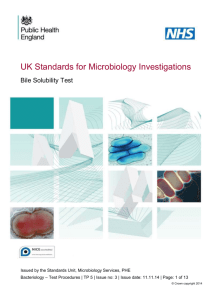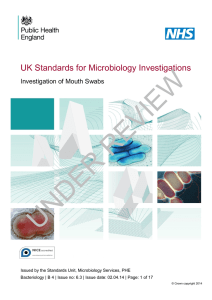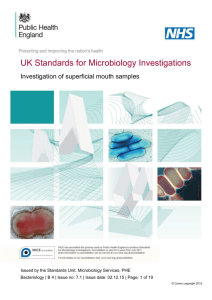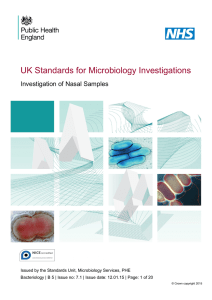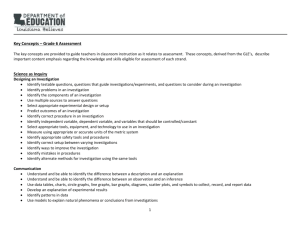B 15i6 November 2014
advertisement
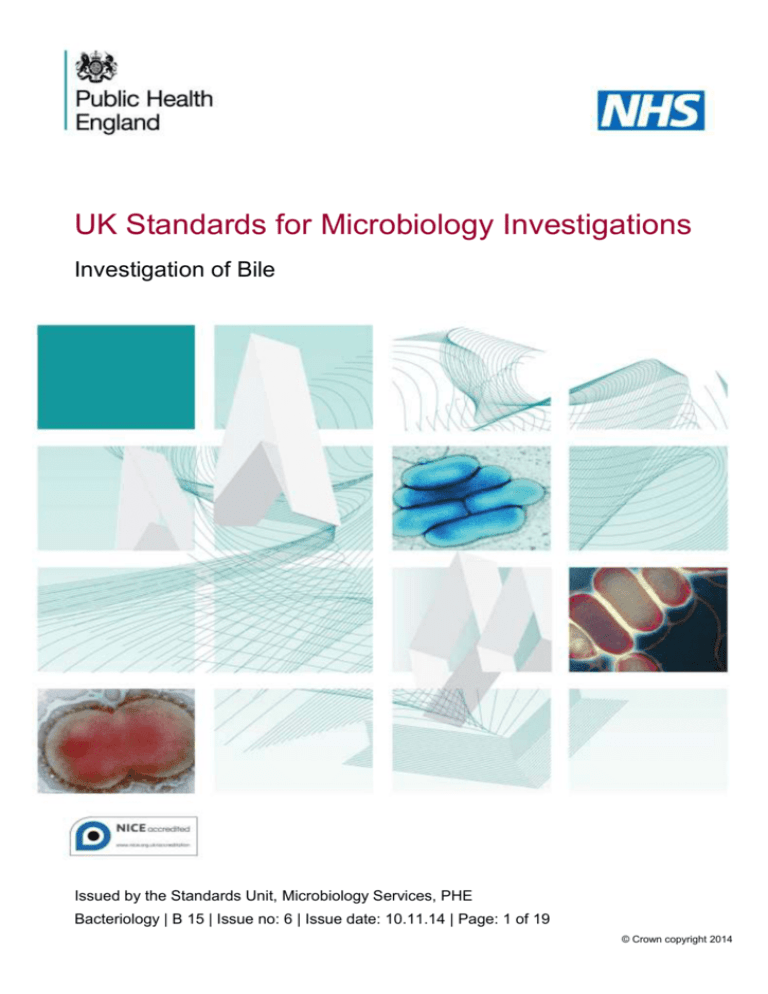
UK Standards for Microbiology Investigations Investigation of Bile Issued by the Standards Unit, Microbiology Services, PHE Bacteriology | B 15 | Issue no: 6 | Issue date: 10.11.14 | Page: 1 of 19 © Crown copyright 2014 Investigation of Bile Acknowledgments UK Standards for Microbiology Investigations (SMIs) are developed under the auspices of Public Health England (PHE) working in partnership with the National Health Service (NHS), Public Health Wales and with the professional organisations whose logos are displayed below and listed on the website https://www.gov.uk/ukstandards-for-microbiology-investigations-smi-quality-and-consistency-in-clinicallaboratories. SMIs are developed, reviewed and revised by various working groups which are overseen by a steering committee (see https://www.gov.uk/government/groups/standards-for-microbiology-investigationssteering-committee). The contributions of many individuals in clinical, specialist and reference laboratories who have provided information and comments during the development of this document are acknowledged. We are grateful to the Medical Editors for editing the medical content. For further information please contact us at: Standards Unit Microbiology Services Public Health England 61 Colindale Avenue London NW9 5EQ E-mail: standards@phe.gov.uk Website: https://www.gov.uk/uk-standards-for-microbiology-investigations-smi-qualityand-consistency-in-clinical-laboratories UK Standards for Microbiology Investigations are produced in association with: Logos correct at time of publishing. Bacteriology | B 15 | Issue no: 6 | Issue date: 10.11.14 | Page: 2 of 19 UK Standards for Microbiology Investigations | Issued by the Standards Unit, Public Health England Investigation of Bile Contents ACKNOWLEDGMENTS .......................................................................................................... 2 AMENDMENT TABLE ............................................................................................................. 4 UK SMI: SCOPE AND PURPOSE ........................................................................................... 5 SCOPE OF DOCUMENT ......................................................................................................... 7 SCOPE .................................................................................................................................... 7 INTRODUCTION ..................................................................................................................... 7 TECHNICAL INFORMATION/LIMITATIONS ........................................................................... 9 1 SAFETY CONSIDERATIONS .................................................................................... 10 2 SPECIMEN COLLECTION ......................................................................................... 10 3 SPECIMEN TRANSPORT AND STORAGE ............................................................... 11 4 SPECIMEN PROCESSING/PROCEDURE ................................................................. 11 5 REPORTING PROCEDURE ....................................................................................... 14 6 NOTIFICATION TO PHE OR EQUIVALENT IN THE DEVOLVED ADMINISTRATIONS .................................................................................................. 14 APPENDIX: INVESTIGATION OF BILE ................................................................................ 16 REFERENCES ...................................................................................................................... 17 Bacteriology | B 15 | Issue no: 6 | Issue date: 10.11.14 | Page: 3 of 19 UK Standards for Microbiology Investigations | Issued by the Standards Unit, Public Health England Investigation of Bile Amendment Table Each SMI method has an individual record of amendments. The current amendments are listed on this page. The amendment history is available from standards@phe.gov.uk. New or revised documents should be controlled within the laboratory in accordance with the local quality management system. Amendment No/Date. 9/10.11.14 Issue no. discarded. 5.2 Insert Issue no. 6 Section(s) involved Amendment Whole document. Hyperlinks updated to gov.uk. Page 2. Updated logos added. Whole document. Contents reviewed and restructured to improve the flow of the document. References. Reviewed and updated. Bacteriology | B 15 | Issue no: 6 | Issue date: 10.11.14 | Page: 4 of 19 UK Standards for Microbiology Investigations | Issued by the Standards Unit, Public Health England Investigation of Bile UK SMI: Scope and Purpose Users of SMIs Primarily, SMIs are intended as a general resource for practising professionals operating in the field of laboratory medicine and infection specialties in the UK. SMIs also provide clinicians with information about the available test repertoire and the standard of laboratory services they should expect for the investigation of infection in their patients, as well as providing information that aids the electronic ordering of appropriate tests. The documents also provide commissioners of healthcare services with the appropriateness and standard of microbiology investigations they should be seeking as part of the clinical and public health care package for their population. Background to SMIs SMIs comprise a collection of recommended algorithms and procedures covering all stages of the investigative process in microbiology from the pre-analytical (clinical syndrome) stage to the analytical (laboratory testing) and post analytical (result interpretation and reporting) stages. Syndromic algorithms are supported by more detailed documents containing advice on the investigation of specific diseases and infections. Guidance notes cover the clinical background, differential diagnosis, and appropriate investigation of particular clinical conditions. Quality guidance notes describe laboratory processes which underpin quality, for example assay validation. Standardisation of the diagnostic process through the application of SMIs helps to assure the equivalence of investigation strategies in different laboratories across the UK and is essential for public health surveillance, research and development activities. Equal Partnership Working SMIs are developed in equal partnership with PHE, NHS, Royal College of Pathologists and professional societies. The list of participating societies may be found at https://www.gov.uk/uk-standards-for-microbiology-investigations-smi-qualityand-consistency-in-clinical-laboratories. Inclusion of a logo in an SMI indicates participation of the society in equal partnership and support for the objectives and process of preparing SMIs. Nominees of professional societies are members of the Steering Committee and Working Groups which develop SMIs. The views of nominees cannot be rigorously representative of the members of their nominating organisations nor the corporate views of their organisations. Nominees act as a conduit for two way reporting and dialogue. Representative views are sought through the consultation process. SMIs are developed, reviewed and updated through a wide consultation process. Quality Assurance NICE has accredited the process used by the SMI Working Groups to produce SMIs. The accreditation is applicable to all guidance produced since October 2009. The process for the development of SMIs is certified to ISO 9001:2008. SMIs represent a good standard of practice to which all clinical and public health microbiology Microbiology is used as a generic term to include the two GMC-recognised specialties of Medical Microbiology (which includes Bacteriology, Mycology and Parasitology) and Medical Virology. Bacteriology | B 15 | Issue no: 6 | Issue date: 10.11.14 | Page: 5 of 19 UK Standards for Microbiology Investigations | Issued by the Standards Unit, Public Health England Investigation of Bile laboratories in the UK are expected to work. SMIs are NICE accredited and represent neither minimum standards of practice nor the highest level of complex laboratory investigation possible. In using SMIs, laboratories should take account of local requirements and undertake additional investigations where appropriate. SMIs help laboratories to meet accreditation requirements by promoting high quality practices which are auditable. SMIs also provide a reference point for method development. The performance of SMIs depends on competent staff and appropriate quality reagents and equipment. Laboratories should ensure that all commercial and in-house tests have been validated and shown to be fit for purpose. Laboratories should participate in external quality assessment schemes and undertake relevant internal quality control procedures. Patient and Public Involvement The SMI Working Groups are committed to patient and public involvement in the development of SMIs. By involving the public, health professionals, scientists and voluntary organisations the resulting SMI will be robust and meet the needs of the user. An opportunity is given to members of the public to contribute to consultations through our open access website. Information Governance and Equality PHE is a Caldicott compliant organisation. It seeks to take every possible precaution to prevent unauthorised disclosure of patient details and to ensure that patient-related records are kept under secure conditions. The development of SMIs are subject to PHE Equality objectives https://www.gov.uk/government/organisations/public-healthengland/about/equality-and-diversity. The SMI Working Groups are committed to achieving the equality objectives by effective consultation with members of the public, partners, stakeholders and specialist interest groups. Legal Statement Whilst every care has been taken in the preparation of SMIs, PHE and any supporting organisation, shall, to the greatest extent possible under any applicable law, exclude liability for all losses, costs, claims, damages or expenses arising out of or connected with the use of an SMI or any information contained therein. If alterations are made to an SMI, it must be made clear where and by whom such changes have been made. The evidence base and microbial taxonomy for the SMI is as complete as possible at the time of issue. Any omissions and new material will be considered at the next review. These standards can only be superseded by revisions of the standard, legislative action, or by NICE accredited guidance. SMIs are Crown copyright which should be acknowledged where appropriate. Suggested Citation for this Document Public Health England. (2014). Investigation of Bile. UK Standards for Microbiology Investigations. B 15 Issue 6. https://www.gov.uk/uk-standards-for-microbiologyinvestigations-smi-quality-and-consistency-in-clinical-laboratories Bacteriology | B 15 | Issue no: 6 | Issue date: 10.11.14 | Page: 6 of 19 UK Standards for Microbiology Investigations | Issued by the Standards Unit, Public Health England Investigation of Bile Scope of Document Type of Specimen Bile Scope This SMI describes the processing and bacteriological investigation of bile. This SMI should be used in conjunction with other SMIs. Introduction Biliary infection can produce significant morbidity and mortality and the prognosis often depends upon whether biliary tract obstruction is present. Gram negative bacteria (mainly Escherichia coli) are the cause of the majority of biliary infections although Gram positive and anaerobic organisms are also found 1,2. Biliary infection presents as either cholangitis or cholecystitis. Bile is normally sterile, however colonisation may occur, frequently with a mixture of aerobes and anaerobes originating from the gut3. Occasionally instrumentation or stenting may lead to colonisation or infection, which may progress to bacteraemia4. Fever, previous endoscopic or percutaneous biliary instrumentation, and bilioenteric anastomosis are significant predictors of a positive bile culture2. Cholangitis3 Cholangitis is the inflammation of the biliary ducts. It may present in two forms, ascending or suppurative cholangitis. Both have similar pathology. Ascending cholangitis5 Ascending cholangitis occurs when partial obstruction of the biliary ducts and bacterial proliferation in the bile occur together3. Bacteria are shed intermittently into the bloodstream. This can develop into suppurative cholangitis. Ascending cholangitis is a common cause of sepsis following liver transplantation. Suppurative cholangitis Suppurative cholangitis occurs when an infected biliary system is completely obstructed. Biliary pressure increases and bacteria are constantly shed into the bloodstream. Diagnosis of infection can be made by aspirating bile and taking blood cultures (B 37 - Investigation of Blood Cultures (for Organisms other than Mycobacterium species). Recurrent pyogenic cholangitis Recurrent pyogenic cholangitis presents as episodes of right abdominal pain, biliary obstruction and cholangitis and Gram negative septicaemia in patients that are chronically infected with biliary parasites. Cholecystitis Cholecystitis is inflammation of the gall bladder. It is usually due to an infection that is often secondary to the presence of gallstones. When the cystic duct is obstructed by a Bacteriology | B 15 | Issue no: 6 | Issue date: 10.11.14 | Page: 7 of 19 UK Standards for Microbiology Investigations | Issued by the Standards Unit, Public Health England Investigation of Bile gallstone the hydrostatic pressure in the gallbladder lumen is increased. This produces pain and infection frequently ensues. Emphysematous Cholecystitis Emphysematous cholecystitis is an acute infective cholecystitis involving gas-forming organisms, most commonly Clostridium perfringens. Gangrene and perforation may result. Endoscopic Retrograde Cholangiopancreatography (ERCP) One of a variety of imaging techniques used to study the biliary tree, whereby an endoscope is passed from the gut via the ampulla of Vater into the biliary ducts. This is minimally invasive but may cause biliary sepsis. Organisms Isolated from Bile include3,5: Enterobacteriaceae Enterococcus species Pseudomonads Bacteroides species Clostridium species Anaerobes Staphylococcus aureus Salmonella Other organisms may be isolated and should be given consideration depending on clinical details. Yeast Infections Yeast infections are rare in normal individuals. They occur in older patients with malignancy, immunocompromised patients, diabetic patients or in patients undergoing antimicrobial treatment for other infections. Such infections may be confined to the biliary tract or be a feature of more general candidosis. They usually involve Candida albicans, but other Candida species have been reported2,6-8. Parasitic Invasion Parasitic invasion of the biliary tract occurs in patients from or in the developing world or those who are immunosuppressed and may involve5: Ascaris lumbricoides Clonorchis sinensis Opisthorchis species Fasciola hepatica Giardia lamblia Cryptosporidium species Microspora Bacteriology | B 15 | Issue no: 6 | Issue date: 10.11.14 | Page: 8 of 19 UK Standards for Microbiology Investigations | Issued by the Standards Unit, Public Health England Investigation of Bile These are described in B 31 - Investigation of Specimens other than Blood for Parasites. Technical Information/Limitations Limitations of UK SMIs The recommendations made in UK SMIs are based on evidence (eg sensitivity and specificity) where available, expert opinion and pragmatism, with consideration also being given to available resources. Laboratories should take account of local requirements and undertake additional investigations where appropriate. Prior to use, laboratories should ensure that all commercial and in-house tests have been validated and are fit for purpose. Selective Media in Screening Procedures Selective media which does not support the growth of all circulating strains of organisms may be recommended based on the evidence available. A balance therefore must be sought between available evidence, and available resources required if more than one media plate is used. Specimen Containers9,10 SMIs use the term “CE marked leak proof container” to describe containers bearing the CE marking used for the collection and transport of clinical specimens. The requirements for specimen containers are given in the EU in vitro Diagnostic Medical Devices Directive (98/79/EC Annex 1 B 2.1) which states: “The design must allow easy handling and, where necessary, reduce as far as possible contamination of, and leakage from, the device during use and, in the case of specimen receptacles, the risk of contamination of the specimen. The manufacturing processes must be appropriate for these purposes”. Bacteriology | B 15 | Issue no: 6 | Issue date: 10.11.14 | Page: 9 of 19 UK Standards for Microbiology Investigations | Issued by the Standards Unit, Public Health England Investigation of Bile 1 Safety Considerations9-25 1.1 Specimen Collection, Transport and Storage9-14 Use aseptic technique. Collect specimens in appropriate CE marked leak proof containers and transport in sealed plastic bags. Compliance with postal, transport and storage regulations is essential. 1.2 Specimen Processing9-25 Containment Level 2. Laboratory procedures that give rise to infectious aerosols must be conducted in a microbiological safety cabinet17. Diagnostic work with clinical material that could possibly contain Hazard Group 3 organisms (Salmonella Typhi and Salmonella Paratyphi A,B & C,) does not normally require full Containment Level 3 containment17 (paragraph 175). If these Hazard Group 3 organisms are suspected, work should take place at a higher containment level but full Containment Level 3 may not be required 17 (paragraphs 179-183). If the work to be carried out requires the growth or manipulation of a Hazard Group 3 enteric biological agent then this has to be carried out under full Containment Level 3 conditions17 (paragraph 175). Refer to current guidance on the safe handling of all organisms documented in this SMI. Note: S. Typhi and S. Paratyphi A, B and C cause severe and sometimes fatal disease and laboratory acquired infections have been reported. S. Typhi vaccination is available. Guidance is given in the Public Health England immunisation policy. The above guidance should be supplemented with local COSHH and risk assessments. 2 Specimen Collection 2.1 Type of Specimens Bile 2.2 Optimal Time and Method of Collection26 For safety considerations refer to Section 1.1. Collect specimens before antimicrobial therapy where possible26. Unless otherwise stated, swabs for bacterial and fungal culture should be placed in appropriate transport medium27-31. Bile may be collected in theatre or from a closed drainage system by aspiration with a needle and syringe. Collect specimens other than swabs into appropriate CE marked leak proof containers and place in sealed plastic bags. Bacteriology | B 15 | Issue no: 6 | Issue date: 10.11.14 | Page: 10 of 19 UK Standards for Microbiology Investigations | Issued by the Standards Unit, Public Health England Investigation of Bile 2.3 Adequate Quantity and Appropriate Number of Specimens26 Ideally, a minimum volume of 1mL. Numbers and frequency of specimen collection are dependent on clinical condition of patient. 3 Specimen Transport and Storage9,10 3.1 Optimal Transport and Storage Conditions For safety considerations refer to Section 1.1. Specimens should be transported and processed as soon as possible 26. If processing is delayed, refrigeration is preferable to storage at ambient temperature26. The volume of specimen influences the transport time that is acceptable. Large volumes of purulent material will maintain the viability of anaerobes for longer32-34. Suggested transport times for varying volumes of specimen when examining for anaerobes34: Volume of aspirated material Optimal time for transport to laboratory <1mL <10min 1mL <30min >2mL <3hr The recovery of anaerobes is compromised if the transport time exceeds 3hr. 4 Specimen Processing/Procedure9,10 4.1 Test Selection Select a representative portion of specimen for appropriate procedures such as examination for parasites (B 31 - Investigation of Specimens other than Blood for Parasites) depending on clinical details. 4.2 Appearance The presence of pus should be noted. 4.3 Sample Preparation For safety considerations refer to Section 1.2. 4.4 Microscopy 4.4.1 Standard Using a sterile pipette place one drop of specimen on to a clean microscope slide. 4.4.2 Supplementary Microscopy for parasites – see B 31 - Investigation of Specimens other than Blood for Parasites. Bacteriology | B 15 | Issue no: 6 | Issue date: 10.11.14 | Page: 11 of 19 UK Standards for Microbiology Investigations | Issued by the Standards Unit, Public Health England Investigation of Bile If a Gram stain is required, spread one drop of the specimen with a sterile loop to make a thin smear on a clean microscope slide. 4.5 Culture and Investigation Using a sterile pipette inoculate each agar plate and enrichment broth, if included, with specimen (see Q 5 - Inoculation of Culture Media for Bacteriology). For the isolation of individual colonies, spread inoculum with a sterile loop. 4.5.1 Culture media, conditions and organisms Clinical details/ Specimen Standard media Incubation Bile Target organism(s) Temp °C Atmos Time Blood agar 35-37 5-10% CO2 40-48hr daily CLED*/ MacConkey agar 35-37 air 16-24hr 16hr Any organism Neomycin fastidious anaerobe agar 35-37 anaerobic 5 d** 5 d*** Anaerobes Cultures read Target organism(s) Salmonella species conditions Cholangitis Cultures read Cholecystitis For these situations, add the following: Clinical details/ Specimen Supplementary media conditions Salmonella carriage/infecti on Bile Mannitol selenite F broth then subcultured to XLD Incubation Temp °C Atmos Time 35-37 air 16-24hr N/A 35-37 air 16-24hr 16hr * CLED agar has only been validated for urine specimens ** incubation may be extended to 14 days; in such cases plates should be read at 5 days and then left in the incubator/cabinet until day 14 *** if the laboratory has an anaerobic cabinet plates may be read at 48 hours, otherwise they should be left until day 5 4.6 Identification Refer to individual SMIs for organism identification. 4.6.1 Minimum level of identification in the laboratory Note: All work on S. Typhi and S. Paratyphi A, B & C must be performed in a microbiological safety cabinet in a Containment Level 3 room. Anaerobes "anaerobes" level β-haemolytic streptococci Lancefield group level Coagulase negative staphylococci "coagulase negative" level Enterobacteriaceae (not Salmonella species) "coliforms" level Enterococci genus level Bacteriology | B 15 | Issue no: 6 | Issue date: 10.11.14 | Page: 12 of 19 UK Standards for Microbiology Investigations | Issued by the Standards Unit, Public Health England Investigation of Bile P. aeruginosa species level Other Pseudomonads "pseudomonads" level Salmonella S. Typhi, S. Paratyphi or other serogroup level S. aureus species level Streptococci genus or Lancefield group level C. albicans species level Other Candida species genus level Parasites see B 31 - Investigation of Specimens other than Blood for Parasites Organisms may be further identified if this is clinically or epidemiologically indicated. 4.7 Antimicrobial Susceptibility Testing Refer to British Society for Antimicrobial Chemotherapy (BSAC) and/or EUCAST guidelines. 4.8 Referral for Outbreak Investigations N/A 4.9 Referral to Reference Laboratories For information on the tests offered, turn around times, transport procedure and the other requirements of the reference laboratory click here for user manuals and request forms. Organisms with unusual or unexpected resistance, and whenever there is a laboratory or clinical problem, or anomaly that requires elucidation should be sent to the appropriate reference laboratory. Contact appropriate devolved national reference laboratory for information on the tests available, turn around times, transport procedure and any other requirements for sample submission: England and Wales https://www.gov.uk/specialist-and-reference-microbiology-laboratory-tests-andservices Scotland http://www.hps.scot.nhs.uk/reflab/index.aspx Northern Ireland http://www.publichealth.hscni.net/directorate-public-health/health-protection β-haemolytic streptococci Serotying S. aureus Spa Typing Salmonella Serotyping and phage typing (if applicable) Fungi Identification and/or susceptibility testing Bacteriology | B 15 | Issue no: 6 | Issue date: 10.11.14 | Page: 13 of 19 UK Standards for Microbiology Investigations | Issued by the Standards Unit, Public Health England Investigation of Bile 5 Reporting Procedure 5.1 Microscopy Report on WBCs and organisms detected. Microscopy for parasites – see B 31 - Investigation of Specimens other than Blood for Parasites. 5.1.1 Microscopy reporting time Urgent microscopy results to be telephoned or sent electronically. Written report 16–72hr. 5.2 Culture Report clinically significant organisms isolated (with an appropriate comment on possible contamination or overgrowth if the specimen is from a collection bag or Ttube) or Report: other growth or absence of growth. Also, report results of supplementary investigations. Culture reporting time. Clinically urgent results to be telephoned or sent electronically. Written report, 16 – 72hr stating, if appropriate, that a further report will be issued. Supplementary investigations Parasites – see B 31 - Investigation of Specimens other than Blood for Parasites. 5.3 Antimicrobial Susceptibility Testing Report susceptibilities as clinically indicated. Prudent use of antimicrobials according to local and national protocols is recommended. 6 Notification to PHE35,36 or Equivalent in the Devolved Administrations37-40 The Health Protection (Notification) regulations 2010 require diagnostic laboratories to notify Public Health England (PHE) when they identify the causative agents that are listed in Schedule 2 of the Regulations. Notifications must be provided in writing, on paper or electronically, within seven days. Urgent cases should be notified orally and as soon as possible, recommended within 24 hours. These should be followed up by written notification within seven days. For the purposes of the Notification Regulations, the recipient of laboratory notifications is the local PHE Health Protection Team. If a case has already been notified by a registered medical practitioner, the diagnostic laboratory is still required to notify the case if they identify any evidence of an infection caused by a notifiable causative agent. Notification under the Health Protection (Notification) Regulations 2010 does not replace voluntary reporting to PHE. The vast majority of NHS laboratories voluntarily report a wide range of laboratory diagnoses of causative agents to PHE and many Bacteriology | B 15 | Issue no: 6 | Issue date: 10.11.14 | Page: 14 of 19 UK Standards for Microbiology Investigations | Issued by the Standards Unit, Public Health England Investigation of Bile PHE Health protection Teams have agreements with local laboratories for urgent reporting of some infections. This should continue. Note: The Health Protection Legislation Guidance (2010) includes reporting of Human Immunodeficiency Virus (HIV) & Sexually Transmitted Infections (STIs), Healthcare Associated Infections (HCAIs) and Creutzfeldt–Jakob disease (CJD) under ‘Notification Duties of Registered Medical Practitioners’: it is not noted under ‘Notification Duties of Diagnostic Laboratories’. https://www.gov.uk/government/organisations/public-health-england/about/ourgovernance#health-protection-regulations-2010 Other arrangements exist in Scotland37,38, Wales39 and Northern Ireland40. Bacteriology | B 15 | Issue no: 6 | Issue date: 10.11.14 | Page: 15 of 19 UK Standards for Microbiology Investigations | Issued by the Standards Unit, Public Health England Investigation of Bile Appendix: Investigation of Bile Prepare specimens For all samples Additional media Cholangitis Cholecystitis Salmonella carriage infection CLED / MacConkey agar Blood agar Incubate at 35-37°C In 5-10% CO2 40 - 48hr Read daily Incubate at 35-37°C In air 16 -24hr Read at 16hr Neomycin / Fastidious anaerobe agar Incubate at 35-37°C Anaerobically 48hr Read at 48hr Mannitol selenite F broth Incubate at 35-37°C In air 16 -24hr Subculture to XLD media Incubate at 35-37°C In air 16 -24hr Read at 16hr Any organism Refer to IDs Anaerobes ID 8, 14, 25 Salmonella sp refer to Bacteriology | B 15 | Issue no: 6 | Issue date: 10.11.14 | Page: 16 of 19 UK Standards for Microbiology Investigations | Issued by the Standards Unit, Public Health England ID 24 Investigation of Bile References 1. Westphal JF, Brogard JM. Biliary tract infections: a guide to drug treatment. Drugs 1999;57:81-91. 2. Brody LA, Brown KT, Getrajdman GI, Kannegieter LS, Brown AE, Fong Y, et al. Clinical factors associated with positive bile cultures during primary percutaneous biliary drainage. J Vasc Interv Radiol 1998;9:572-8. 3. Sinanan MN. Acute cholangitis. Infect Dis Clin North Am 1992;6:571-99. 4. Hochwald SN, Burke EC, Jarnagin WR, Fong Y, Blumgart LH. Association of preoperative biliary stenting with increased postoperative infectious complications in proximal cholangiocarcinoma. Arch Surg 1999;134:261-6. 5. Kinney TP. Management of ascending cholangitis. Gastrointest Endosc Clin N Am 2007;17:289306, vi. 6. Ehrenstein BP, Salamon L, Linde HJ, Messmann H, Scholmerich J, Gluck T. Clinical determinants for the recovery of fungal and mezlocillin-resistant pathogens from bile specimens. Clinical Infectious Diseases 2002;34:902-8. 7. Irani M, Truong LD. Candidiasis of the extrahepatic biliary tract. Arch Pathol Lab Med 1986;110:1087-90. 8. Cervia JS, Murray HW. Fungal cholecystitis and AIDS. J Infect Dis 1990;161:358. 9. European Parliament. UK Standards for Microbiology Investigations (SMIs) use the term "CE marked leak proof container" to describe containers bearing the CE marking used for the collection and transport of clinical specimens. The requirements for specimen containers are given in the EU in vitro Diagnostic Medical Devices Directive (98/79/EC Annex 1 B 2.1) which states: "The design must allow easy handling and, where necessary, reduce as far as possible contamination of, and leakage from, the device during use and, in the case of specimen receptacles, the risk of contamination of the specimen. The manufacturing processes must be appropriate for these purposes". 10. Official Journal of the European Communities. Directive 98/79/EC of the European Parliament and of the Council of 27 October 1998 on in vitro diagnostic medical devices. 7-12-1998. p. 1-37. 11. Health and Safety Executive. Safe use of pneumatic air tube transport systems for pathology specimens. 9/99. 12. Department for transport. Transport of Infectious Substances, 2011 Revision 5. 2011. 13. World Health Organization. Guidance on regulations for the Transport of Infectious Substances 2013-2014. 2012. 14. Home Office. Anti-terrorism, Crime and Security Act. 2001 (as amended). 15. Advisory Committee on Dangerous Pathogens. The Approved List of Biological Agents. Health and Safety Executive. 2013. p. 1-32 16. Advisory Committee on Dangerous Pathogens. Infections at work: Controlling the risks. Her Majesty's Stationery Office. 2003. 17. Advisory Committee on Dangerous Pathogens. Biological agents: Managing the risks in laboratories and healthcare premises. Health and Safety Executive. 2005. Bacteriology | B 15 | Issue no: 6 | Issue date: 10.11.14 | Page: 17 of 19 UK Standards for Microbiology Investigations | Issued by the Standards Unit, Public Health England Investigation of Bile 18. Advisory Committee on Dangerous Pathogens. Biological Agents: Managing the Risks in Laboratories and Healthcare Premises. Appendix 1.2 Transport of Infectious Substances Revision. Health and Safety Executive. 2008. 19. Centers for Disease Control and Prevention. Guidelines for Safe Work Practices in Human and Animal Medical Diagnostic Laboratories. MMWR Surveill Summ 2012;61:1-102. 20. Health and Safety Executive. Control of Substances Hazardous to Health Regulations. The Control of Substances Hazardous to Health Regulations 2002. 5th ed. HSE Books; 2002. 21. Health and Safety Executive. Five Steps to Risk Assessment: A Step by Step Guide to a Safer and Healthier Workplace. HSE Books. 2002. 22. Health and Safety Executive. A Guide to Risk Assessment Requirements: Common Provisions in Health and Safety Law. HSE Books. 2002. 23. Health Services Advisory Committee. Safe Working and the Prevention of Infection in Clinical Laboratories and Similar Facilities. HSE Books. 2003. 24. British Standards Institution (BSI). BS EN12469 - Biotechnology - performance criteria for microbiological safety cabinets. 2000. 25. British Standards Institution (BSI). BS 5726:2005 - Microbiological safety cabinets. Information to be supplied by the purchaser and to the vendor and to the installer, and siting and use of cabinets. Recommendations and guidance. 24-3-2005. p. 1-14 26. Baron EJ, Miller JM, Weinstein MP, Richter SS, Gilligan PH, Thomson RB, Jr., et al. A Guide to Utilization of the Microbiology Laboratory for Diagnosis of Infectious Diseases: 2013 Recommendations by the Infectious Diseases Society of America (IDSA) and the American Society for Microbiology (ASM). Clin Infect Dis 2013;57:e22-e121. 27. Rishmawi N, Ghneim R, Kattan R, Ghneim R, Zoughbi M, Abu-Diab A, et al. Survival of fastidious and nonfastidious aerobic bacteria in three bacterial transport swab systems. J Clin Microbiol 2007;45:1278-83. 28. Barber S, Lawson PJ, Grove DI. Evaluation of bacteriological transport swabs. Pathology 1998;30:179-82. 29. Van Horn KG, Audette CD, Sebeck D, Tucker KA. Comparison of the Copan ESwab system with two Amies agar swab transport systems for maintenance of microorganism viability. J Clin Microbiol 2008;46:1655-8. 30. Nys S, Vijgen S, Magerman K, Cartuyvels R. Comparison of Copan eSwab with the Copan Venturi Transystem for the quantitative survival of Escherichia coli, Streptococcus agalactiae and Candida albicans. Eur J Clin Microbiol Infect Dis 2010;29:453-6. 31. Tano E, Melhus A. Evaluation of three swab transport systems for the maintenance of clinically important bacteria in simulated mono- and polymicrobial samples. APMIS 2011;119:198-203. 32. Isenberg HD, Washington JA II, Doern GV, Amsterdam D. Specimen collection and handling. In: Balows A, Hausler WJ J, Herrmann KL, Isenberg HD, Shadomy HJ, editors. Manual of Clinical Microbiology. 5th ed. Washington D.C.: American Society for Microbiology; 1991. p. 15-28. 33. Vandepitte J, Engbaek K, Piot P, Heuck CC. Basic Laboratory Procedures in Clinical Bacteriology. 1991. 34. Holden J. Collection and transport of clinical specimens for anaerobic culture. In: Isenberg HD, editor. Clinical Microbiology Procedures Handbook.Vol 1. Washington D.C.: American Society for Microbiology; 1992. p. 2.2.1-7. Bacteriology | B 15 | Issue no: 6 | Issue date: 10.11.14 | Page: 18 of 19 UK Standards for Microbiology Investigations | Issued by the Standards Unit, Public Health England Investigation of Bile 35. Public Health England. Laboratory Reporting to Public Health England: A Guide for Diagnostic Laboratories. 2013. p. 1-37. 36. Department of Health. Health Protection Legislation (England) Guidance. 2010. p. 1-112. 37. Scottish Government. Public Health (Scotland) Act. 2008 (as amended). 38. Scottish Government. Public Health etc. (Scotland) Act 2008. Implementation of Part 2: Notifiable Diseases, Organisms and Health Risk States. 2009. 39. The Welsh Assembly Government. Health Protection Legislation (Wales) Guidance. 2010. 40. Home Office. Public Health Act (Northern Ireland) 1967 Chapter 36. 1967 (as amended). Bacteriology | B 15 | Issue no: 6 | Issue date: 10.11.14 | Page: 19 of 19 UK Standards for Microbiology Investigations | Issued by the Standards Unit, Public Health England
